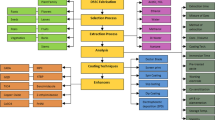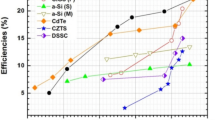Abstract
Employing the prepared pure TiO2 and Ni doped TiO2 as photoanode material, dye sensitized solar cells (DSSCs) are fabricated with ruthenium complex as dye-sensitizer [Cis-bis(isothiocyanato) bis(2, 2′-bipyridyl-4, 4′-dicarboxylato)ruthenium(II) also called as N3 dye] and LiI as redox electrolyte. In this concern, pure TiO2 and Ni–TiO2 are prepared through sol–gel technique. The structural, optical and electrical properties of the prepared materials are investigated using XRD, UV–Vis and impedance analyses respectively. The XRD pattern reveals pure crystalline anatase phase of pure TiO2 and Ni–TiO2 and the crystallite size was found to be in the range of 7–11 nm. UV–Vis spectroscopy shows the enhancement of absorption spectrum in UV region with red shift was observed by Ni doping. The electron transport properties of the prepared TiO2 and Ni doped TiO2 shows higher conductivity in 3% Ni doped TiO2 confirmed from impedance studies. The interfacial charge transport resistances and chemical capacitances of the fabricated DSSCs are evaluated from the EIS investigations and the photovoltaic performance of Ni doped TiO2 based DSSC shows enhanced efficiency up to 4%.










Similar content being viewed by others
References
T.M. Razykov, C.S. Ferekides, D. Morel, E. Stefanakos, H.S. Ullal, H.M. Upadhyaya, Solar photovoltaic electricity: current status and future prospects. Sol. Energy 85(8), 1580–1608 (2011). doi:10.1016/j.solener.2010.12.002
M. Grätzel, Dye-sensitized solar cells. J. Photochem. Photobiol. 4, 145–153 (2003). doi:10.1016/S1389-5567(03)00026-1
P. Vijayakumar, M. Senthil Pandian, S.P. Lim, A. Pandikumar, N.M. Huang, S. Mukhopadhyay, P. Ramasamy, Facile synthesis of tungsten carbide nanorods and its application as counter electrode in dye sensitized solar cells. Mater. Sci. Semicond. Process. 39, 292–299 (2015). doi:10.1016/j.mssp.2015.05.023
H. Choi, C. Nahm, J. Kim, J. Moon, S. Nam, D.-R. Jung, B. Park, The effect of TiCl4-treated TiO2 compact layer on the performance of dye-sensitized solar cell. Curr. Appl. Phys. 12(3), 737–741 (2012). doi:10.1016/j.cap.2011.10.011
B. O’Regan, M Grätzel, A low-cost, high-efficiency solar cell based on dye-sensitized colloidal TiO2 films. Nature 353, 737–740 (1991). doi:10.1038/353737a0
S. Kundu, P. Sarojinijeeva, R. Karthick, G. Anantharaj, G. Saritha, R. Bera, S. Anandan, A. Patra, P. Ragupathy, M. Selvaraj, D. Jeyakumar, K.V. Pillai, Enhancing the efficiency of DSSCs by the modification of TiO2 photoanodes using N, F and S, co-doped graphene quantum dots. Electrochim. Acta 242, 337–343 (2017). doi:10.1016/j.electacta.2017.05.024
K. Ashok Kumar, D. Ramesh, M. Gunaseelan, K. Subalakshmi, J. Senthilselvan, Structural, optical and impedance studies of hydrothermally and solvothermally prepared SnO2 nanocrystallites for conducting electrode application. Trans. Indian Inst. Met. 68(2), 221–225 (2015). doi:10.1007/s12666-015-0563-3
S.P. Lim, A. Pandikumar, H.N. Lim, R. Ramaraj, N.M. Huang, Boosting photovoltaic performance of dye-sensitized solar cells using silver nanoparticle-decorated N,S-Co-doped-TiO2 photoanode. Sci. Rep. 5, 1–14 (2015). doi:10.1038/srep11922
J.-Q. Bai, W. Wen, J.-M. Wu, Facile synthesis of Ni-doped TiO2 ultrathin nanobelt arrays with enhanced photocatalytic performance. CrystEngComm 18(10), 1847–1853 (2016). doi:10.1039/c6ce00015k
R.S. Dubey, S. Singh, Investigation of structural and optical properties of pure and chromium doped TiO2 nanoparticles prepared by solvothermal method. Results Phys. (2017). doi:10.1016/j.rinp.2017.03.014
L.A. Patil, D.N. Suryawanshi, I.G. Pathan, D.M. Patil, Nickel doped spray pyrolyzed nanostructured TiO2 thin films for LPG gas sensing. Sens. Actuators B 176, 514–521 (2013). doi:10.1016/j.snb.2012.08.030
J.K. Salem, T.M. Hammad, R.R. Harrison, Synthesis, structural and optical properties of Ni-doped ZnO micro-spheres. J. Mater. Sci. 24(5), 1670–1676 (2013). doi:10.1007/s10854-012-0994-0
C. Wang, Z. Chen, H. Jin, C. Cao, J. Li, Z. Mi, Enhancing visible-light photoelectrochemical water splitting through transition-metal doped TiO2 nanorod arrays. J. Mater. Chem. A 2(42), 17820–17827 (2014). doi:10.1039/c4ta04254a
G. Yang, Z. Jiang, H. Shi, T. Xiao, Z. Yan, Preparation of highly visible-light active N-doped TiO2 photocatalyst. J. Mater. Chem. 20(25), 5301–5309 (2010). doi:10.1039/c0jm00376j
S.G. Babu, R. Vinoth, D. Praveen Kumar, M.V. Shankar, H.-L. Chou, K. Vinodgopal, B. Neppolian, Influence of electron storing, transferring and shuttling assets of reduced graphene oxide at the interfacial copper doped TiO2 p-n heterojunction for increased hydrogen production. Nanoscale 7(17), 7849–7857 (2015). doi:10.1039/c5nr00504c
T. Sun, J. Fan, E. Liu, L. Liu, Y. Wang, H. Dai, Y. Yang, W. Hou, X. Hu, Z. Jiang, Fe and Ni co-doped TiO2 nanoparticles prepared by alcohol-thermal method: application in hydrogen evolution by water splitting under visible light irradiation. Powder Technol. 228, 210–218 (2012). doi:10.1016/j.powtec.2012.05.018
B. Parveen, M. Hassan, Z. Khalid, S. Riaz, S. Naseem, Room-temperature ferromagnetism in Ni-doped TiO2 diluted magnetic semiconductor thin films. J. Appl. Res. Technol. 15(2), 132–139 (2017). doi:10.1016/j.jart.2017.01.009
D. Jing, Y. Zhang, L. Guo, Study on the synthesis of Ni doped mesoporous TiO2 and its photocatalytic activity for hydrogen evolution in aqueous methanol solution. Chem. Phys. Lett. 415(1–3), 74–78 (2005). doi:10.1016/j.cplett.2005.08.080
Q. liu, D. Ding, C. Ning, X. Wang, Reduced N/Ni-doped TiO2 nanotubes photoanodes for photoelectrochemical water splitting. RSC Adv. 5(116), 95478–95487 (2015). doi:10.1039/c5ra21805e
B. Gao, T. Wang, X. Fan, H. Gong, H. Guo, W. Xia, Y. Feng, X. Huang, J. He, Synthesis of yellow mesoporous Ni-doped TiO2 with enhanced photoelectrochemical performance under visible light. Inorg. Chem. Front. 4(5), 898–906 (2017). doi:10.1039/c6qi00609d
R. Ghosh Chaudhuri, S. Paria, Visible light induced photocatalytic activity of sulfur doped hollow TiO2 nanoparticles, synthesized via a novel route. Dalton Trans. 43(14), 5526–5534 (2014). doi:10.1039/c3dt53311e
M.T. Laranjo, N.C. Ricardi, L.T. Arenas, E.V. Benvenutti, M.C. de Oliveira, M.J.L Santos, T.M.H. Costa, TiO2 and TiO2/SiO2 nanoparticles obtained by sol–gel method and applied on dye sensitized solar cells. J. Sol-Gel. Sci. Technol. 72(2), 273–281 (2014). doi:10.1007/s10971-014-3341-5
D. Arun Kumar, J. Merline Shyla, F.P. Xavier, Synthesis and characterization of TiO2/SiO2 nano composites for solar cell applications. Appl. Nanosci. 2(4), 429–436 (2012). doi:10.1007/s13204-012-0060-5
S. Mugundan, B. Rajamannan, G. Viruthagiri, N. Shanmugam, R. Gobi, P. Praveen, Synthesis and characterization of undoped and cobalt-doped TiO2 nanoparticles via sol–gel technique. Appl. Nanosci. 5(4), 449–456 (2015). doi:10.1007/s13204-014-0337-y
H. Zhang, Z. Xing, Y. Zhang, Z. Li, X. Wu, C. Liu, Q. Zhu, W. Zhou, Ni2+ and Ti3+ co-doped porous black anatase TiO2 with unprecedented-high visible-light-driven photocatalytic degradation performance. RSC Adv. 5(129), 107150–107157 (2015). doi:10.1039/c5ra23743b
K. Ashok Kumar, J. Manonmani, J. Senthilselvan, Effect on interfacial charge transfer resistance by hybrid co-sensitization in DSSC applications. J. Mater. Sci. 25(12), 5296–5301 (2014). doi:10.1007/s10854-014-2304-5
R. Vinoth, P. Karthik, K. Devan, B. Neppolian, M. Ashokkumar, TiO2-NiO p-n nanocomposite with enhanced sonophotocatalytic activity under diffused sunlight. Ultrason. Sonochem. 35(Pt B), 655–663 (2016). doi:10.1016/j.ultsonch.2016.03.005
K. Subalakshmi, K.A. Kumar, J. Senthilselvan, Reduction of 4-nitrophenol using electrocatalytic ZnS nanoparticles for counter electrode application in dye-sensitized solar cells. AIP Conf. Proc. 1832(1), 110057 (2017). doi:10.1063/1.4980681
K.A. Kumar, K. Subalakshmi, J. Senthilselvan, Effect of mixed valence state of titanium on reduced recombination for natural dye-sensitized solar cell applications. J. Solid State Electrochem. 20(7), 1921–1932 (2016). doi:10.1007/s10008-016-3191-x
K.A. Kumar, K. Subalakshmi, J. Senthilselvan, Co-sensitization of natural dyes for improved efficiency in dye-sensitized solar cell application. AIP Conf. Proc. 1731(1), 060017 (2016). doi:10.1063/1.4947823
R. Govindaraj, M. Senthil Pandian, G. Senthil Murugan, P. Ramasamy, S. Mukhopadhyay, Synthesis of porous titanium dioxide nanorods/nanoparticles and their properties for dye sensitized solar cells. J. Mater. Sci. 26(4), 2609–2613 (2015). doi:10.1007/s10854-015-2731-y
Acknowledgements
The author TS thank, SRM University for the research fellowship and thank CeNSE, IISc Bangalore, India for photovoltaic studies.
Author information
Authors and Affiliations
Corresponding author
Ethics declarations
Conflict of interest
The authors declare that there is no conflict of interest.
Rights and permissions
About this article
Cite this article
Sakthivel, T., Kumar, K.A., Senthilselvan, J. et al. Effect of Ni dopant in TiO2 matrix on its interfacial charge transportation and efficiency of DSSCs. J Mater Sci: Mater Electron 29, 2228–2235 (2018). https://doi.org/10.1007/s10854-017-8137-2
Received:
Accepted:
Published:
Issue Date:
DOI: https://doi.org/10.1007/s10854-017-8137-2




